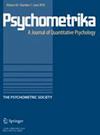认知诊断中一般非参数分类方法的一致性理论。
IF 3.1
2区 心理学
Q1 MATHEMATICS, INTERDISCIPLINARY APPLICATIONS
引用次数: 0
摘要
认知诊断模型(CDMs)已广泛应用于教育、心理学和社会科学等领域。虽然参数似然估计是拟合cdm的一种流行方法,但非参数方法由于易于实现和鲁棒性而越来越受到关注,特别是在样本量相对较小的情况下。然而,现有的非参数估计方法的一致性结果往往依赖于一定的限制条件,在实际应用中不容易得到满足。本文在较弱和较实际的条件下,重新建立了一般非参数分类方法的一致性理论。本文章由计算机程序翻译,如有差异,请以英文原文为准。
Consistency Theory of General Nonparametric Classification Methods in Cognitive Diagnosis.
Cognitive diagnosis models (CDMs) have been popularly used in fields such as education, psychology, and social sciences. While parametric likelihood estimation is a prevailing method for fitting CDMs, nonparametric methodologies are attracting increasing attention due to their ease of implementation and robustness, particularly when sample sizes are relatively small. However, existing consistency results of the nonparametric estimation methods often rely on certain restrictive conditions, which may not be easily satisfied in practice. In this article, the consistency theory for the general nonparametric classification method is reestablished under weaker and more practical conditions.
求助全文
通过发布文献求助,成功后即可免费获取论文全文。
去求助
来源期刊

Psychometrika
数学-数学跨学科应用
CiteScore
4.40
自引率
10.00%
发文量
72
审稿时长
>12 weeks
期刊介绍:
The journal Psychometrika is devoted to the advancement of theory and methodology for behavioral data in psychology, education and the social and behavioral sciences generally. Its coverage is offered in two sections: Theory and Methods (T& M), and Application Reviews and Case Studies (ARCS). T&M articles present original research and reviews on the development of quantitative models, statistical methods, and mathematical techniques for evaluating data from psychology, the social and behavioral sciences and related fields. Application Reviews can be integrative, drawing together disparate methodologies for applications, or comparative and evaluative, discussing advantages and disadvantages of one or more methodologies in applications. Case Studies highlight methodology that deepens understanding of substantive phenomena through more informative data analysis, or more elegant data description.
 求助内容:
求助内容: 应助结果提醒方式:
应助结果提醒方式:


